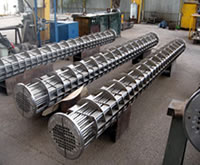Shell and Tube Heat Exchangers
Introduction
Shell and tube heat exchangers consist of a series of tubes. Shell & tube heat exchangers set of these tubes contains the fluid that must be either heated. The Shell and Tube Heat Exchangers has the advantages of removability of tube bundle and access for cleaning both inner and outer side of tubes and shell. The second fluid runs over the tubes that are being heated or cooled, it can either provide the heat or absorb the heat required. Shell and Tube Heat Exchanger is most common type of heat exchanger in oil refineries and other large chemical processes, and is suited for higher-pressure applications. Shell Tubes Heat Exchanger is classified into fixed and floating type Heat Exchangers. The tube sheets are completely welded to the shell and acted as shell flanges. Fixed type Heat Exchangers are used there are absolutely no chances for inter mixing of two fluids.
Specifications of Shell and Tube Heat Exchanger:
- Shell Tube Heat Exchanger is widely used in variety of application as a cooling solution. With right combination of materials they can also be used to cool or heat other mediums.
- Shell Tube Heat Exchanger common among them is for cooling of Hydraulic Fluid and oil in engines, transmissions or hydraulic power packs.
Applications of Shell and Tube Heat Exchanger:
- Shell Tube Heat Exchanger using a heat exchanger is that they are often easy to service, particularly with models where a floating tube bundle the tube plates are not welded to the outer shell is available on fixed tube sheet heat exchangers
Features of Shell and Tube Heat Exchanger:
- Universal corrosion resistance an excellent alternative to expensive MOCs like graphite, hastelloy, copper titanium, tantalum and other exotic metals.
- Excellent heat transfer as fouling does not occur on smooth glass surfaces.
- Flexibility of installation vertical/horizontal.
- Easy replacement of tubes for repair and cleaning.
- Available in wide range of HTAs.
- Ease of installation due to light weight.
- Suitable for applications where large HTAs are required in limited space.
Advantages:
- Shell and Tube Heat Exchanger is used both the properties of steel and fighting to corrosion are mandatory.
- Shell Tube Heat Exchanger differs from carbon steel by the amount of chromium present and rusts readily when exposed to air and moisture.
Images:


